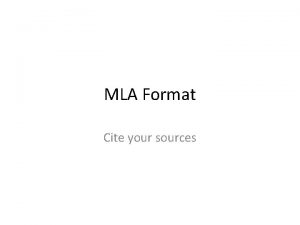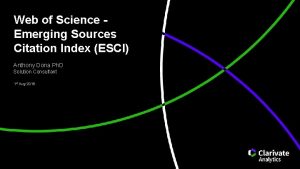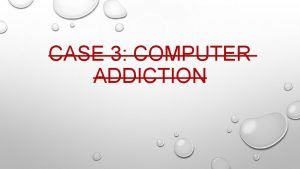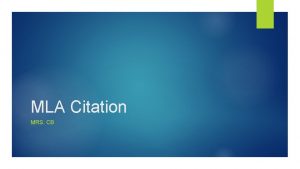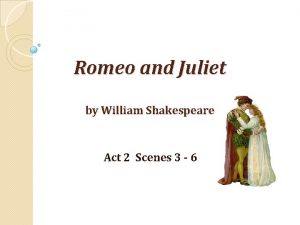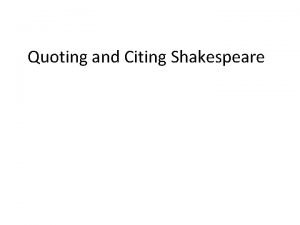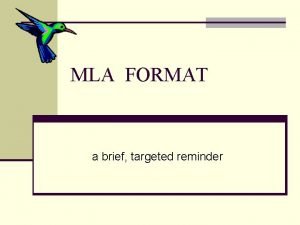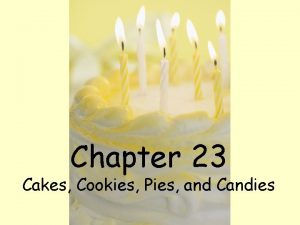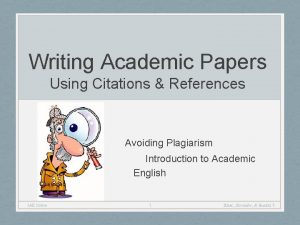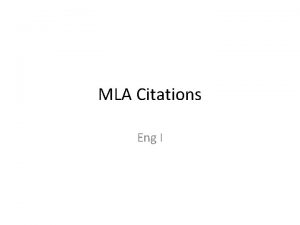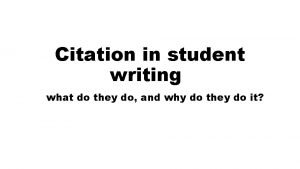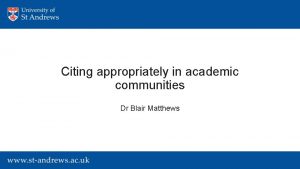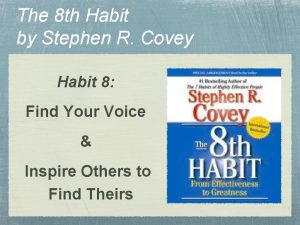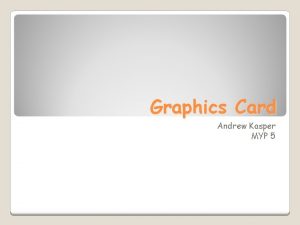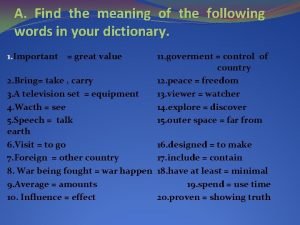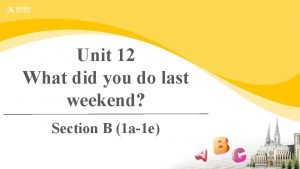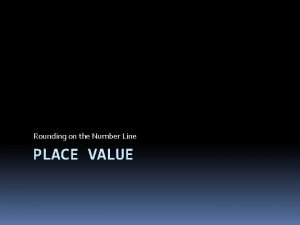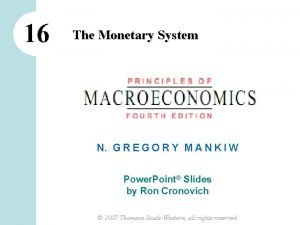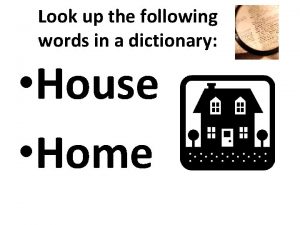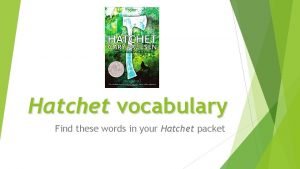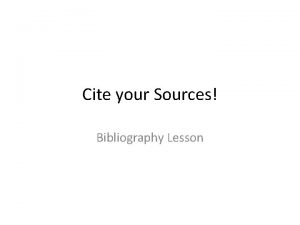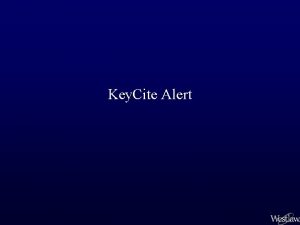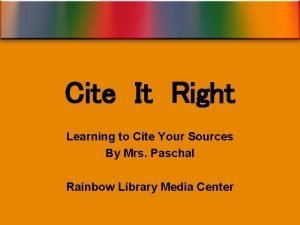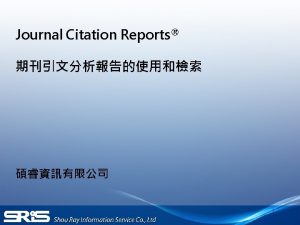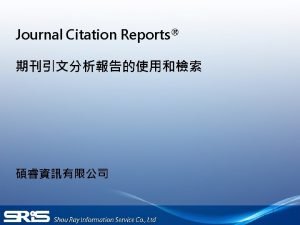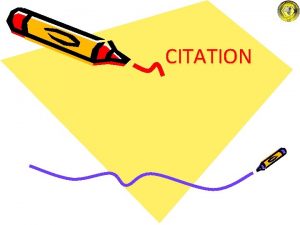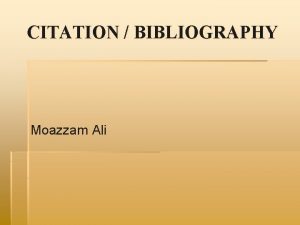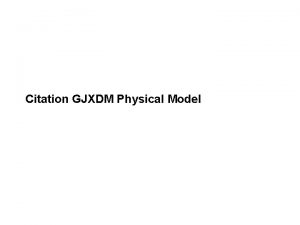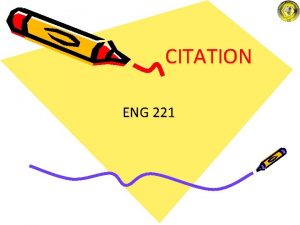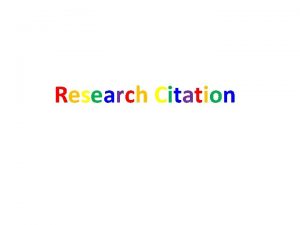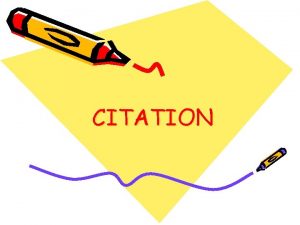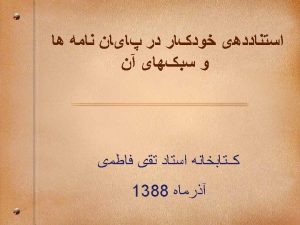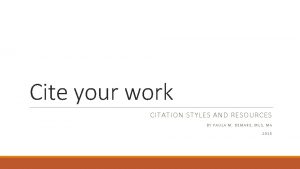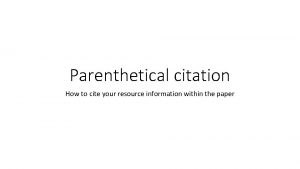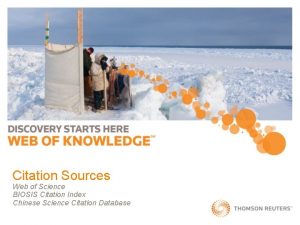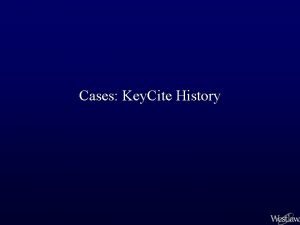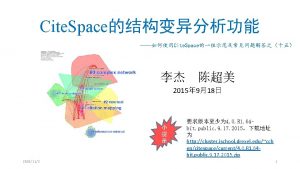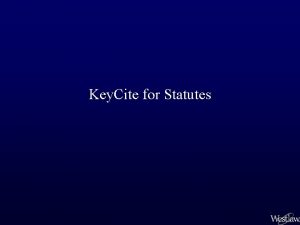SOURCES AND CITATION Find sources cite your sources



































- Slides: 35

SOURCES AND CITATION Find sources, cite your sources, and avoid plagiarism

Evaluating Sources • Know if your source is trustworthy or not. • This is very important! If you are getting your information from a bad source, it can throw off your whole essay. • First thing to look for when determining if a source it legit: • Does the article have an author? • Does the article have a date of publication? • Does the website match the article? • If the article is about a political issue and the website is something like “freecallingcards. com” this is NOT a reliable source

General Internet Research: • You can also get more accurate research on Google if you learn to use Google’s filters. (“News” is a useful filter) • Do not ever cite Wikipeida as a source. It is NOT considered a reliable or academic source. • If you absolutely cannot find the information anywhere else, you may look at a Wikipedia entry for ONE PURPOSE ONLY: To use their citation system to find the ORIGINAL SOURCE of the information. When you see a number link in a wiki article, click and it will take you to a citation at the bottom of the page. You may use this to go to the original source. • If the claim or information is not cited, it cannot be fully trusted. Do not use it, or search for it elsewhere.

Library Research • One of the best places to do research is at the library • You can ask the librarians to help you with research! • You can find books on your topic! (yes, even recent topics!) • You can access e-books through the library • And probably most useful of all, you can find articles through the Library Databases. • Databases on the Library Website that will probably be useful are: • CQ Researcher (limited number of topics, but excellent in-depth coverage) • Opposing Viewpoints (again, limited topics, but very good information)

So what are Reputable Web Sources? • Reputable websites: reliable news sources, websites run by trustworthy organizations • Treat websites with caution. The internet contains a wealth of information, but unless you know the credentials of the person posting the opinions/interpretations of a work, tread carefully. Come see me if you have any questions. • Material from any of our Library Databases

There are Three Steps to Using Sources: 1. Find sources and choose the best ones for your purpose. 2. Read the sources carefully, only use basic information and short quotes that you actually need—DON’T use their wording or way of explaining things—and use your sources as a springboard for your own writing on the subject. 3. Quote or paraphrase the sources in your essay, and cite them giving proper credit in the body of the essay (intext citations) and at the end (works cited page), using MLA format.

More Advice on Sources • Just because you find a source and read it doesn’t mean you have to use it. If you read a source and don’t like it, keep looking. • Keep researching throughout the writing process. If you find a wonderful source with all kinds of good ideas you want to respond to after you wrote a draft, that’s fine. Include that source and your response when you revise. • Keep track of every source you use ideas or quotes from in your paper. • You will need to be able to find the source again when you give it credit. Keep track of your sources as you go.

What Is MLA Format? • MLA Stands for “Modern Language Association” • The MLA makes rules for the writers of research papers in English and the Humanities so that everyone who is doing research is following the same set of rules

What kinds of things do I need to do to have correct MLA Format? • Part of MLA style is format. • Margins • Heading • Font, etc. • Please see the formatting example that is on class blog for my expectations on formatting. • Part of MLA style is citation. • This means giving credit to your sources and avoiding plagiarism. • Citation is also meant to make is easy for your reader find your sources if he or she wishes to read them.

MLA Citation has two main parts: 1. In-text citations (also called parenthetical citations) • Ex: (Anderson 3) – Are in the body (main text) of your essay. – Come after each paraphrase or quote that you did not write or think of yourself, you must indicate which source you are using in order to avoid plagiarism. Consult your textbook, a handbook, or the handout on class blog for more detail. 2. A Works Cited page: – On its own page at the end of your essay – Lists every source you used in alphabetical order by the last name of the author. – Each works cited entry must contain specific information in a specific order. Consult a handbook or the handout for more details.

MLA In-Text Citation An in-text citation is the place where you give credit to a source in the body of your paper. • All direct quotations are enclosed in quote marks • Author’s last name and page number where quote is found included in parentheses after the quote • Your in-text citation should both give credit to your source and send your reader to your Works Cited page to find your entry for the source you have just quoted.

Four Basic Rules for Avoiding Plagiarism Make sure all word-for-word quotes have quote marks showing where they begin and end. 2. Make sure to make the difference between your ideas and your sources’ ideas clear when paraphrasing. 3. Identify where each quote OR paraphrased idea came from in the body of your paper using intext citations. 4. Make sure that each source you quote OR paraphrase in your paper is correctly listed on your Works Cited page. 1. Pass out the Incorporating Sources Handout

How to Avoid Drop-in Quotes: One of the risk factors for heart disease is alcohol consumption. The American Heart Association website states, “drinking too much alcohol can raise blood pressure, cause heart failure and lead to stroke” (“Risk Factors”). • Notice that the quote is a part of a sentence written by the author of the paper. • Adding “(Insert source name here) states” to the beginning of a quotation is a quick, easy way to fix drop-in quotes. • This is called a “signal phrase. ” • You are encouraged to embed your quote into your own sentence: • Example: People worried about heart disease should seriously limit how much they drink because “drinking too much alcohol can raise blood pressure” or even cause death or stroke (“Risk Factors”).

The “Quote Sandwich” • This is a way to integrate quotes into your paper smoothly and avoid drop-in quotes. • The first piece of “bread” • Introduce quote, possibly mention author, connect quote to what you were saying before. • The “Meat” • Your quote, correctly cited with in-text citation. • The second piece of “bread” • Interpretation/explanation of quote (NOT simply rewording the quote), and connect quote to what you will say next.

Online Examples of Quote Sandwiches • http: //www. csun. edu/~hflrc 006/quote. html • https: //sites. google. com/site/sasamtani/quote_sandwich 003. jpg • Notice that both of these examples make the quote a part of a sentence the essay author wrote, and notice that both examples give credit to the source’s author.

To Cite, or Not to Cite • You do not have to cite facts that are undisputed common knowledge. – Ex: The Battle of Gettysburg began on July 1, 1863. – Ex: Water is made up of two hydrogen atoms and one oxygen atom. – Ex: Dublin is the capital of the Republic of Ireland. • However, once you start needing to use ideas about these common, everyday facts that you found in your sources, you must cite the source of the idea. • When in doubt, cite! And if you have time, ask!

Some Myths about Plagiarism • Myth 1: As long as I have a source on my works cited page, I don’t • • • have to mention it in the body of my paper. WRONG! Any time you use ideas or words from a source, you must include an in-text citation. Myth 2: It’s ok to copy/paste a paragraph or a few lines into my essay and then change some words and call it a paraphrase. If I changed some words, I can call it my writing! WRONG! Changing some words and replacing them with synonyms is STILL PLAGIARISM if you keep the original ideas and/or sentence structure. DON’T COPY/PASTE UNLESS YOU PUT IT IN QUOTATION MARKS. Myth 3: As long as I paraphrase correctly, using my own words and sentence structure to express an idea, I don’t need an in-text citation. WRONG! Even if you use your own words, if the idea originally came from somewhere else, you must cite it.

Myths about Plagiarism • Myth 4: I don’t need to cite exact words, ideas or information I find on the internet. • WRONG! Treat your internet sources with the same respect you have for your print or online database sources. • Myth 5: It is appropriate to use an old essay from a friend, buy an essay, or have someone help me write an essay using his or her wording instead of mine. • WRONG! All of these are called collusion, and they are all plagiarism. • Myth 6: I won’t get caught if I plagiarize. • WRONG! Plagiarism is quite obvious to most professors, and many of them use plagiarism detecting software.

BREAK TIME! Please return in 10 -15 minutes

Discussing the Readings and Talking About Thesis

Ways to Improve Your Memory –page 36 • Discussion Questions: Did you learn anything new from this article? Was it informative (despite it being so short)? 2. Of the 6 different memory techniques that this article lists, which one do you find the most helpful? 1. Does everyone in your group have a different answer to this question, or do most people answer the same? 3. Does this short article have a thesis? If so what is it? 1. Remember, a thesis is not a question, although this author does use a lot of questions at the beginning of his article. 4. Notice how each paragraph has a different focus or main point. Does this improve the essay’s organization?

The Playlist’s the Thing –page 169 • Discussion Questions: 1. 2. 3. 4. 5. Based on the article, describe at least three positive effects of music on exercise. How does the author define the terms “rhythm” and “harmony”? Did you learn anything from this article? Was it informative? Besides a textbook, where might you find this article published? What is your favorite workout song?

General Tips about Thesis Statements • A statement that contains the essay’s topic and point(s) • Gives the reader a sense of what the essay will be about • Most thesis statements are only one sentence and it must be a complete sentence. • Should not be a question. • You can ask a rhetorical question in your intro, but it is not the same as your thesis. • Everything in the essay must connect back to thesis in some way.

General Tips about Thesis Statements • Usually comes at the end of the introduction: • Introduction paragraph should follow this format: • Attention getter (commonly known as a “hook”) • Introduce the topic and give background leading up to thesis • State thesis

Thesis Statement Practice • If you had to write a thesis statement for your informative essay right now, what would it be? • Remember, your thesis is your main idea, the primary thing you want to inform people about in this essay. • A thesis should be a statement, not a question. • Try out a couple different ways of writing your thesis, at least two or three. If you have not decided on a topic yet, try writing a thesis for each topic you are thinking about. • I will give you all about 15 minutes to come up with two or three tentative thesis statements. • When I call time, you will trade thesis statements with a partner. • Give each other feedback on your topics and which thesis statement works best!

MLA Citation Examples

Book Citation



Citing an entire website

Citing an Article from a Website:

Citing a work in an anthology or textbook:



Next Week: Week 10 – Tuesday, December 1 • In Class: Peer Review for The Informative Essay Due: • Rough Draft Essay 4: The Informative Essay • Bring 3 or 4 copies PRINTED for Peer Review
 Psychology citation style
Psychology citation style How to cite a source mla
How to cite a source mla Esci clarivate
Esci clarivate Print and web sources
Print and web sources Advice from tablets for schools to avoid computer addiction
Advice from tablets for schools to avoid computer addiction Give us your hungry your tired your poor
Give us your hungry your tired your poor Importance of water
Importance of water Definition of ideal self
Definition of ideal self Romeo and juliet mla citation
Romeo and juliet mla citation Axial movement.
Axial movement. How to cite a shakespeare quote
How to cite a shakespeare quote What is the setting of romeo and juliet
What is the setting of romeo and juliet A servant named balthasar tells romeo that juliet is
A servant named balthasar tells romeo that juliet is Are shakespeare plays italicized
Are shakespeare plays italicized How to cite romeo and juliet
How to cite romeo and juliet Cite at least 2 examples of shortened and unshortened cakes
Cite at least 2 examples of shortened and unshortened cakes Unit 5 operating your business lesson 1 funding sources
Unit 5 operating your business lesson 1 funding sources What are your sources of hope or comfort
What are your sources of hope or comfort Paragraph writing
Paragraph writing Citing and referencing difference
Citing and referencing difference Difference between citation and reference
Difference between citation and reference Of mice and men citation mla
Of mice and men citation mla Non integral citation
Non integral citation Non integral citation
Non integral citation Your conscious awareness of your own name
Your conscious awareness of your own name I hope you know somebody loves you
I hope you know somebody loves you Whole person paradigm
Whole person paradigm How to find your pirate name
How to find your pirate name Find your graphics card
Find your graphics card Ahoy mateys or maties
Ahoy mateys or maties Give the meaning of the following words
Give the meaning of the following words So what did you do last saturday
So what did you do last saturday Rounding with a number line
Rounding with a number line While cleaning your apartment you find a $50 bill
While cleaning your apartment you find a $50 bill Look up the following words in a dictionary
Look up the following words in a dictionary What does ruefully mean in hatchet
What does ruefully mean in hatchet

